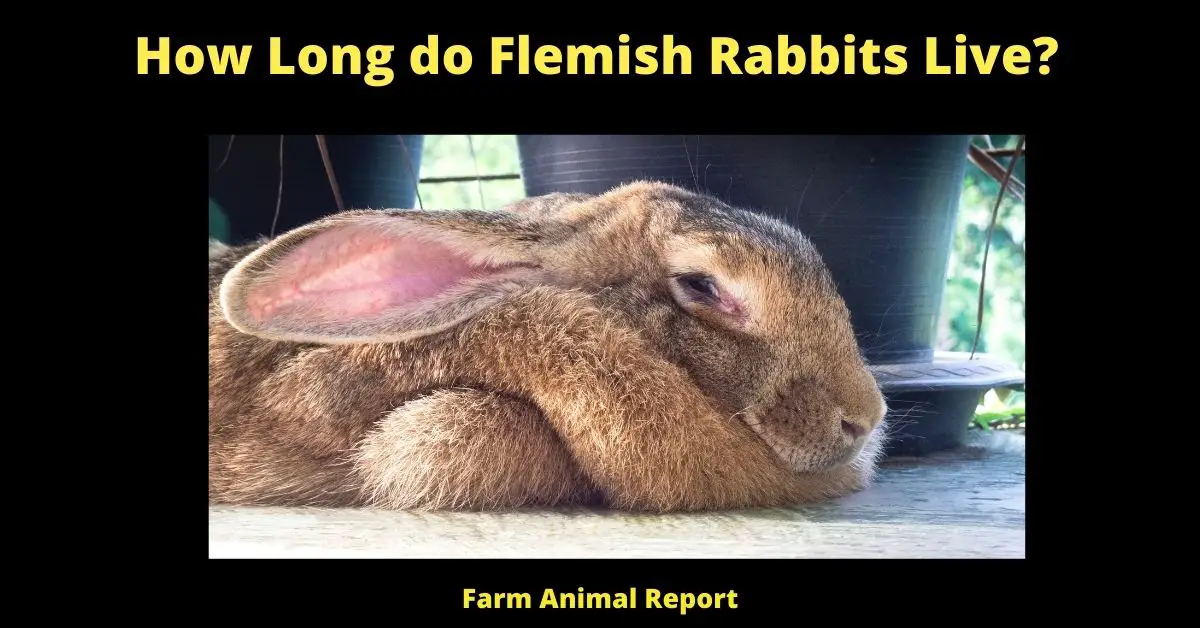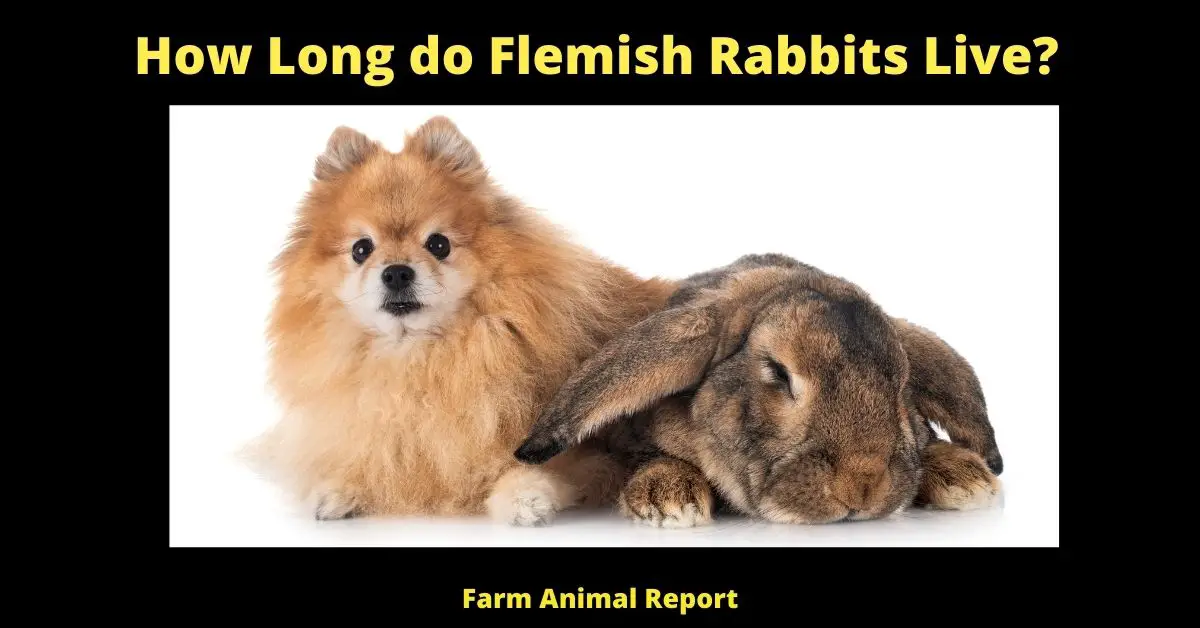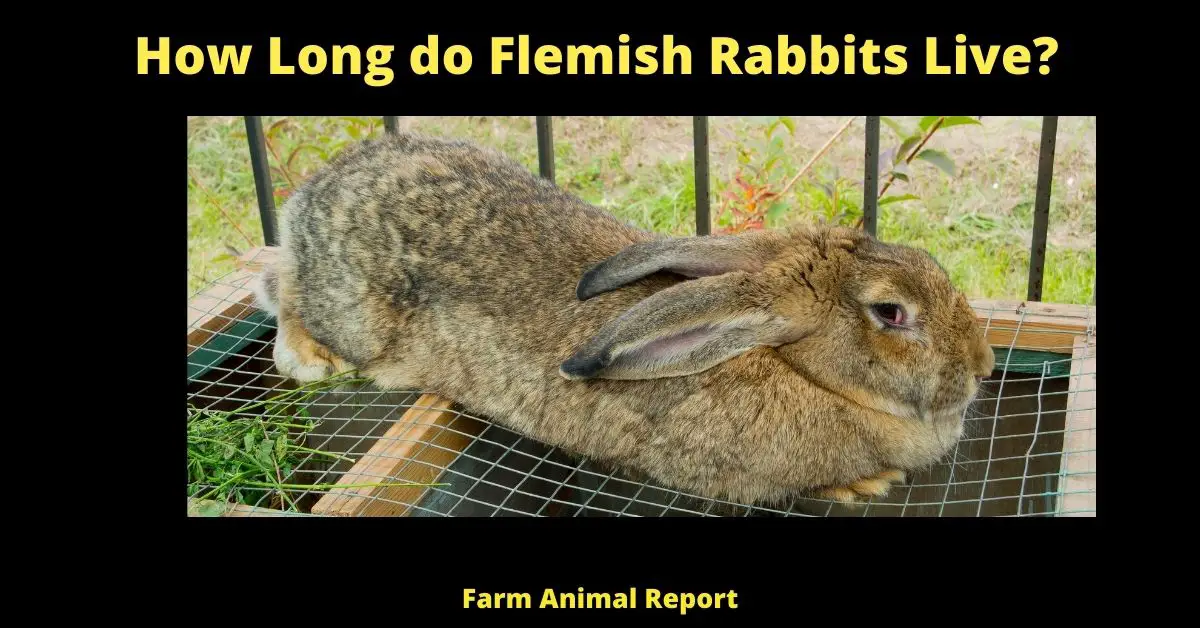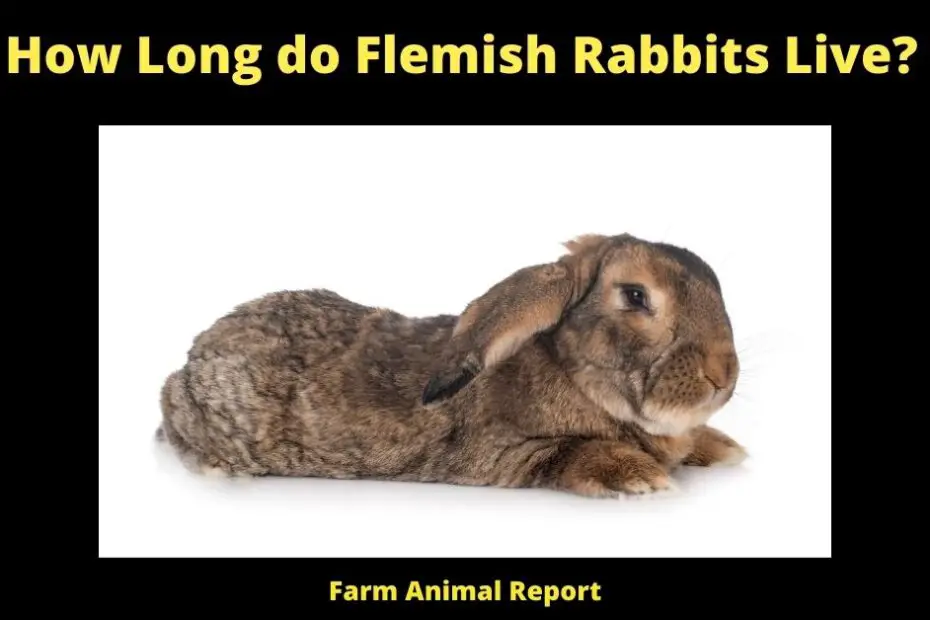8 – 12 Years – Flemish rabbits are a large breed of domestic rabbit that can weigh up to 12 – 20 pounds. They are known for their dense, soft fur, which is often used in the production of fur garments. Flemish rabbits originated in Belgium, and they were first brought to North America in the early 20th century.
How Long do Flemish Rabbits Live?
Today, they are one of the most popular breeds of pet rabbits. Flemish rabbits have an average lifespan of 8-10 years. However, with proper care and diet, they can live for 12 years or more. The oldest recorded Flemish rabbit was 19 years old.
Common health problems that can shorten a Flemish rabbit’s life include obesity, dental problems, and respiratory infections regular exercise, a healthy diet, and annual veterinary check-ups can help extend a Flemish rabbit’s lifespan.
Check Out Amazon for Resources about Breeding Rabbits
If you’re thinking about getting a Flemish rabbit, you may be wondering how long they live. In this article, we will discuss the average lifespan of Flemish rabbits and what you can do to help them live a long and healthy life. How Long do Flemish Rabbits Live?
What does a Flemish Giant Rabbit Look Like?
The Flemish Giant Rabbit is a large breed of rabbit that originates from Belgium. They are one of the oldest rabbit breeds in existence and were first mentioned in literature in the 16th century.
Flemish Giants are known for their large size, with adult rabbits weighing between 10 and 20 pounds. They have a sturdy, rectangular body shape with thick fur that comes in a variety of colors, including black, blue, fawn, white, and steel.

The breed standard calls for a long, arched neck and strong hind legs. German artist Albrecht Dürer even featured a Flemish Giant Rabbit in one of his drawings from the early 1500s! Today, these gentle giants are popular pets around the world. Thanks to their docile nature and affectionate dispositions, they make excellent companions for families with children.
What Colors do Flemish Giants Come in?
Flemish giant rabbits come in a variety of colors, including black, blue, fawn, light gray, steel gray, and white. The most common color is black, followed by blue.
Fawn is a light brown color with a hint of gray, while light gray is a delicate shade of gray. Steel gray is a darker gray, and white is, of course, pure white. There are also two types of patterns that can occur in Flemish giant rabbits: point and broken.
Pointed rabbits have a coloring that is darker on the tips of their fur, while broken-colored rabbits have patches of color that are interspersed with one another. No matter what color or pattern your Flemish giant rabbit is, they are sure to be a beautiful and unique pet.
What is the Diet of a Flemish Giant Rabbit?
Flemish giant rabbits are one of the largest breeds of domestic rabbits, weighing up to 22 pounds. They are also one of the oldest rabbit breeds, originating in Belgium in the 16th century.
Flemish giant rabbits have a diet that consists mostly of hay, fresh vegetables, and a small number of pellets. hay should make up the majority of their diet, as it is essential for their digestive health.
Fresh vegetables should be given daily and can include dark leafy greens, carrots, and celery. A small number of pellets should be given as well, although too many pellets can cause obesity. As a result, a healthy diet for a Flemish giant rabbit includes hay, fresh vegetables, and a small number of pellets.

What size Cage do you need for a Flemish Giant Rabbits?
Flemish Giant Rabbits are the largest of the rabbit breeds, so they require a spacious home. The minimum cage size for a Flemish Giant Rabbit is six feet by two feet by two feet, but bigger is always better.
This provides plenty of room for the rabbit to move around, as well as a designated area for eating and sleeping. The cage should also be equipped with a litter box, water bottle, and toys. hay racks, tunnels, and hiding boxes make good choices. With plenty of space to roam and plenty of activities to keep them occupied, Flemish Giant Rabbits can live happy and healthy lives in their cages.
What Vaccinations do you need for a Pet Flemish Giant Rabbit?
Flemish Giant rabbits are a large breed of domestic rabbit that originated in Belgium. They are the biggest rabbit breed in the world and can weigh up to 22 pounds. These rabbits are popular pets due to their gentle nature and friendly personalities.
However, like all rabbits, they require special care and attention. One important aspect of care is vaccination.
- Flemish Giant rabbits should be vaccinated against two diseases: myxomatosis and viral hemorrhagic disease (VHD).
- Myxomatosis is a highly contagious viral disease that affects rabbits, causing fever, swelling, and media congestion.
VHD is another highly contagious viral disease that affects rabbits, causing diarrhea, vomiting, and bleeding. Both of these diseases can be deadly, so it is important to make sure your Flemish Giant rabbit is up-to-date on its vaccinations. You should talk to your veterinarian about the best vaccination schedule for your pet.

What Health Problems do Flemish Giant Rabbits have?
Flemish Giant rabbits are the largest breed of domestic rabbit, and they are known for being gentle and docile. However, like all animals, they are susceptible to a number of health problems.
Common health problems for Flemish Giant rabbits include obesity, dental problems, and respiratory infections. Obesity is a particular concern for this breed, as their oversized bodies can put strain on their heart and lungs.
To avoid obesity, it is important to feed Flemish Giants a high-fiber diet and provide them with plenty of opportunities to exercise.
Dental problems are also common in this breed, as their teeth continue to grow throughout their lifetime. This can lead to overgrown teeth, which can be painful and make it difficult for the rabbit to eat.
To prevent dental problems, it is important to provide Flemish Giants with plenty of chew toys and hay to gnaw on. Lastly, respiratory infections are a risk for all rabbits, but they can be particularly dangerous for Flemish Giants due to their large size.
If a Flemish Giant develops a respiratory infection, it is important to take them to the vet immediately for treatment.
What do Farmers Raise Flemish Giant Rabbits for?
Flemish Giant Rabbits were originally bred for their meat. However, these days they are more commonly kept as pets.
They are the largest breed of domestic rabbit and can weigh up to 20 pounds. They are also known for being relatively calm and easy to handle, making them a good choice for families with small children.
In addition to their size and personality, Flemish Giant Rabbits are also popular for their fur. Their coat is thick and dense, making it ideal for use in clothing and other textile products. As a result, Flemish Giant Rabbits are still raised by many farmers for their fur.
How to Breed Flemish Giant Rabbits?
7 Simple steps to Breeding Healthy Flemish Rabbits are;
The Flemish Giant is a very large breed of rabbit that can weigh up to 22 pounds. They are a popular breed for pet owners and rabbiting enthusiasts alike due to their docile nature and impressive size.
Breeding Flemish Giant rabbits can be a rewarding experience, but it is important to be aware of the challenges that come with owning such large animals. Here are some tips for successfully breeding Flemish Giant rabbits:
- Find a good quality stud rabbit. A healthy stud rabbit is vital for producing strong, healthy offspring. Make sure to find a stud rabbit that comes from a reputable breeder.
- Be prepared for large litters. Due to their large size, Flemish Giant rabbits often have litters of 8-12 kittens. This means that you will need to have enough cages and food to accommodate all of the babies.
- Feed your rabbits a nutritious diet. A healthy diet is especially important for pregnant or nursing Doe’s. Make sure to provide plenty of hay, fresh vegetables, and high quality pellets.
- Provide plenty of space. Flemish Giant rabbits need a lot of room to exercise and play. If you are keeping them in a cage, make sure it is large enough for them to move around comfortably.
- Handle your rabbits with care. Due to their large size, Flemish Giant rabbits can be easily injured if they are not handled carefully. Make sure to support their back end when picking them up, and never grab them by the ears or feet.
- Watch for health problems. Like all animals, Flemish Giant rabbits are susceptible to health problems. Be on the lookout for signs of illness, such as runny eyes or nose, sneezing, wheezing, or diarrhea. If you notice any of these symptoms, take your rabbit to the vet immediately.
- Be patient. Flemish Giant rabbits can live for up to 12 years, so you will need to be prepared for a long-term commitment. Breeding them is a rewarding experience, but it takes time and patience to do it successfully.
By following these tips, you can be sure that you will have a successful experience breeding Flemish Giant rabbits. With a little bit of planning and care, you can produce healthy, happy kittens that will bring joy to your home for many years to come.
How many Flemish Baby Rabbits are born at a time?
Due to their large size, Flemish Giant rabbits often have litters of 8-12 kittens. This means that you will need to have enough cages and food to accommodate all of the babies. The gestation period is about 31 days.
What are some Flemish Giant Rabbit Health Problems?
Flemish Giant rabbits are susceptible to health problems, just like any other animal. Be on the lookout for signs of illness, such as runny eyes or nose, sneezing, wheezing, or diarrhea. If you notice any of these symptoms, take your rabbit to the vet immediately. Some common health problems that affect Flemish Giant rabbits include:
- Dental problems: Due to their large teeth, Flemish Giant rabbits are prone to dental issues. Overgrown teeth can cause pain and make it difficult for the rabbit to eat properly.
- Ear infections: Ear infections are common in rabbits due to their long ears. If you notice your rabbit scratching its ears or shaking its head, it may be a sign of an infection.
- Gastrointestinal problems: Gastrointestinal issues are common in rabbits and can be caused by a variety of things, such as stress, diet, or parasites. If your rabbit is having diarrhea or vomiting, take it to the vet right away.
- Obesity: Due to their sedentary lifestyle, Flemish Giant rabbits are prone to obesity. Make sure to feed them a healthy diet and provide plenty of opportunities for exercise.
- Pasteurella: Pasteurella is a bacteria that can cause respiratory infections in rabbits. If your rabbit is sneezing or has runny eyes, it may be a sign of pasteurella.
What Parasites do Flemish Giant Rabbits get?
- Ear Mites
- Round Worms
- Tape Worms
- Coccidia
How do I deworm my Flemish Giant Rabbit?
- The best way to Deworm your Flemish Giant Rabbit is to take them to the vet and have them prescribe the appropriate medicine. You can also purchase over-the-counter deworming medication, but it is important to make sure that you get the correct type for rabbits. Some common medications used to treat parasites in rabbits include:
- Panacur C
- Safe-Guard
- Drontal
Can I give my Flemish Giant Rabbit a bath?
It is not recommended to give your Flemish Giant Rabbit a bath as they are susceptible to stress and chilling easily. If you must bathe your rabbit, use warm water and be sure to support their back end. After the bath, towel dry your rabbit and put them in a warm, dry place to rest.
What is the best way to groom my Flemish Giant Rabbit?
The best way to groom your Flemish Giant Rabbit is to brush them regularly with a soft-bristled brush. This will help remove any loose hair and keep their coat healthy.
You should also trim their nails every few weeks with a nail trimmer designed for rabbits. If you are not comfortable doing this yourself, you can take your rabbit to a professional groomer or vet.
How often should I feed my Flemish Giant Rabbit?
Flemish Giant rabbits should be fed twice a day, once in the morning and once at night. They should have a constant supply of hay, as well as fresh vegetables and water. You can also give them a small number of pellets each day.
What is the best way to litter train my Flemish Giant Rabbit?
The best way to litter train your Flemish Giant Rabbit is to start them out in a small area, such as a bathroom or laundry room. Put their food, water, and litter box in the same area so they get used to it. Once they are comfortable using the litter box, you can gradually increase the size of their area until they are free to roam around your home.
How do you take care of a Flemish Rabbit?
Flemish Giant rabbits need a lot of room to exercise and play. If you are keeping them in a cage, make sure it is large enough for them to move around comfortably.
They also need a nutritious diet that includes hay, fresh vegetables, and high-quality pellets. Handle your rabbits with care, and be on the lookout for signs of illness. With a little bit of planning and care, you can have a successful experience breeding Flemish Giant rabbits.
When are Flemish Giant Kits weaned?
Flemish Rabbit babies are typically weaned between six and eight weeks old. At this point, they will need to be moved to their own cage and given a diet of hay, fresh vegetables, and high-quality pellets.
Make sure to handle them with care, as they are still susceptible to injury. With a little bit of patience and love, you will have happy, healthy kittens in no time.
When can you Eat a Flemish Giant Rabbit?
When raising Flemish Giant Rabbits for meat, they are typically slaughtered between eight and twelve weeks old. This is when they reach their peak weight and the meat is almost tender. If you are planning on eating your rabbit, make sure to feed it a healthy diet and provide plenty of exercise to ensure the best quality meat.
What happens if my Flemish Giant Rabbit dies?
If your Flemish Giant Rabbit dies, you will need to dispose of the body properly. The easiest way to do this is to bury it in a shallow grave. You can also contact your local animal shelter or humane society to see if they have any recommendations. Whatever you do, make sure you handle the situation with care and respect.
What countries have the most Flemish Giant Rabbits?
The population of Flemish Giant Rabbits is highest in the United States, followed by Canada, Australia, and the United Kingdom. These countries have the ideal climate for raising rabbits and have a long history of doing so. In recent years, there has been an increase in the number of Flemish Giant Rabbits being bred in other parts of the world, such as Asia and Africa.
Final Thoughts – How Long do Flemish Rabbits Live?
Flemish giant rabbits are a large breed of domesticated rabbit that is known for its gentle disposition and impressive size. Full-grown adults can weigh up to 18 pounds and measure over two feet in length. Despite their name, Flemish giant rabbits are not actually from Flanders (a region in Belgium), but were first bred in England in the early 19th century.
These rabbits quickly became popular as pets and show animals, and today they continue to be widely kept as both companions and meat rabbits. When properly cared for, Flemish giant rabbits can live for 8-12 years.
However, like all domesticated animals, they are susceptible to a number of health problems, including obesity, heart disease, and intestinal issues. As a result, it is important to provide these rabbits with plenty of exercise and a nutritious diet in order to keep them healthy and prolong their lifespan.





